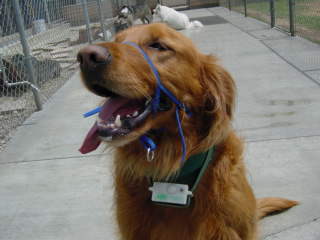Page 2
Verbal
Corrections
The
short, sharp sound of "Aah-Aah!"
is quite effective to
interrupt most
dogs. This is the quickest and
least severe verbal correction.
Saying "Aah or Acht!"
grabs the pet's attention.
and alerts him that you are not
pleased with his behavior. Be sure to praise
the dog the second he responds by stopping
what he was doing wrong.
Right
after you successfully
interrupt the dog with a verbal
correction, change your voice
to an emotionally neutral tone
and with a friendly
body posture, give the dog an
instruction. As soon as
the dog responds
correctly to the instruction,
use the
same word in a higher, happy
tone and loose, friendly body posture as a reward
(e.g., "Good Sit!").
When the dog ignores or responds
incorrectly to your instruction,
use the same word in
a stronger, low tone voice
raising your body to full height.
In this context, the verbal
cue becomes an
INSTRUCTIVE REPRIMAND.
The
"Instructive
Reprimand"
not only corrects the
current behavior, but communicates
what the dog should
be doing instead. The most
common examples are,
"Quiet!"
and "Off!"
Almost any
Instruction can be used with
an urgent voice tone such
as,
"Sit!", "Down!", "Stay!"
and
"Come!"
|
While it's true that dogs
can learn to recognize the
meaning of some words, they
pay attention not only to
the sound of the word but
also to your
posture and your
tone of voice. |
"No!"
is the classic verbal correction.
The disadvantage of "No!"
is that is not specific
enough to clearly communicate to
the dog exactly what
he's done wrong. "No" does not
provide any instruction on what
to do instead.
"No!" may
confuse the dog if he thinks he is being
corrected for where or how he
is sitting, or for simply being
in a room, or for blinking an
eye, or for doing anything that
might be true at the moment
you say it.
Does
this mean you must never use
"No!" to
correct your dog? On the contrary;
there is a place for "No!"
as a non specific verbal
correction. You can use "No!"
to get your dog's attention
and simply interrupt the undesirable behavior.
Just don't confuse this word
with a clear training lesson
because it is not an effective
training method.
Physical,
Non-Painful Corrections
The use
of a head halter such as Gentle Leader™ gives the dog a
clear message and you gentle
control over the dog's behavior.
This head collar puts
pressure both around the dog's muzzle
and behind the head. Gentle
leaders help control leash
pulling, jumping up, and
control behaviors.
Gentle Leader™ gives the dog a
clear message and you gentle
control over the dog's behavior.
This head collar puts
pressure both around the dog's muzzle
and behind the head. Gentle
leaders help control leash
pulling, jumping up, and
control behaviors.
Collar Corrections
requires the dog to abstract
what you want as you correct
the dog. A proper collar
correction simply gets the
dog's attention so that you can
give a clear instruction or
praise the dog for stopping a
behavior such as pulling on
leash. The collar should never
be or stay tight. A collar
correction is a gentle, quick
tug-release that does not cause
pulling or discomfort or pain.
The goal is to communicate, "Hey! Pay attention
to me!"
Similar
to taping someone on the
shoulder tell them something.
Go to
Page 3 - Verbal Corrections
|
Words your dog knows can be used to
instruct, correct and praise
your dog by varying your
voice tone and body
postures. |